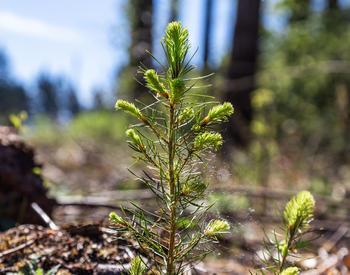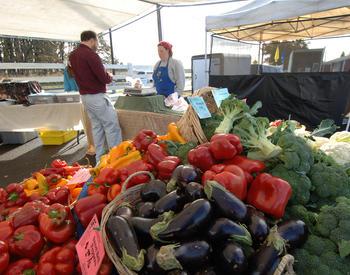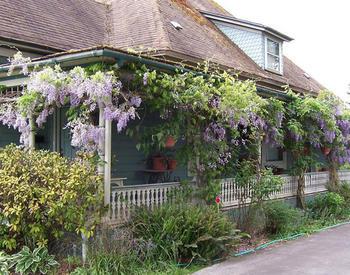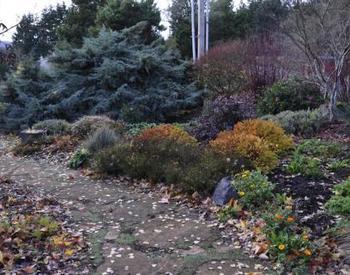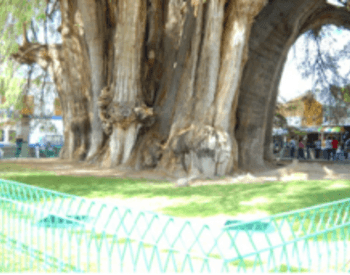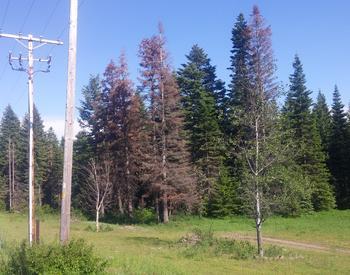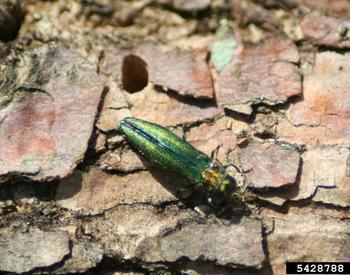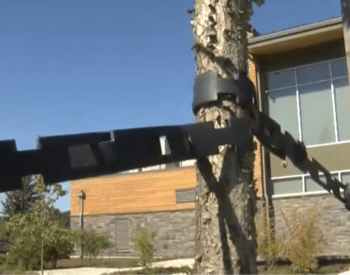Transcript
In the Woods Podcast, Episode 50 - Oregon Forest Practices Act – Transcripts
AI Generated Transcripts edited by Carrie Cantrell for accuracy.
Introduction to In the Woods Podcast
Lauren: From the Oregon State University's Extension Service, you are listening to In the Woods with the Forestry and Natural Resources Program. This podcast brings the forest to listeners by sharing the stories and voices of forest scientists, land managers, and enthusiastic members of the public. Each episode, we will bring you research and science-based information that aims to offer some insight into what we know and are still learning about forest science and management. Stick around to discover a new topic related to forests on each episode. Thank you for joining us on another episode of In the Woods.
Meet Your Host and Today's Topic
Lauren: I'm Lauren Grand, Oregon State University Extension Forester and Associate Professor of Practice in the College of Forestry. And I'll be your host for today's episode. On today's episode, we'll be learning all about Oregon's forest practice laws. Did you know that Oregon's forests are highly regulated when we manage them? Today I've got two amazing guests who are going to talk to us all about these laws and let us know their history and what we need to know when it comes to managing our forests and doing it in a way that protects Oregon resources.
Introducing Our Guests: Julie Woodward and Jennifer Ward
Lauren: Today on the podcast, we've got Julie Woodward. Julie is the director of forestry for the Oregon Forest Resources Institute. Welcome, Julie. Say hi and tell us a little bit about yourself.
Julie Woodward: Thanks Lauren. Well, we’re excited to be here with you. I'm Julie Woodward, the director of forestry with the Oregon Forest Resources Institute or OFRI. And OFRI is a state agency that supports the forest sector and is the stewardship of natural resources. By advancing Oregonians understanding of the social, environmental, and economic benefits of our forest. And we do that through forestry education. And I get the honor of being part of our landowner education programs, as well as we have a K 12 and public programs that we do outreach to all Oregonians. And I've been with OFRI for over 20 years, and you've just been able to really connect with Oregonians and landowners across Oregon. And that's really. The best thing that I find in my position is just being able to connect with all of our amazing folks throughout all the woods.
Lauren: Thanks, Julie. We also have Jennifer Ward. Jennifer is the Oregon department of forestry training lead for the forest resources division. Welcome to the podcast, Jennifer.
Jennifer Ward: Thanks, Lauren. My name's Jennifer Ward and I'm with Oregon department of forestry. I've been with Oregon department of forestry for almost 17 years now. Prior to this position, I was a stewardship forester out of the office for 9 years and came to the forest resources division. I'm excited about helping stewardship foresters, small forest landowner foresters, and landowners and operators learn about the rules so that they can all be successful.
Lauren: That's great. It's so nice to have somebody that's dedicated to making sure everybody knows what the rules are and that you're here to join us.
History and Purpose of the Oregon Forest Practices Act
Lauren: Okay let's get started with a little bit of background about the Oregon Forest Practices Act. Julie, can you tell us a little bit about the history?
Julie Woodward: The Oregon Forest Practices Act, we have to go back to the era of the 1970s. And in this era, if you think about, we had a lot of environmental movement happening across the country. Here in Oregon, we know Oregonians love their forest, as we still do today, and we value those forests and resources. We also had a lot of people being good stewards on the land, who were practicing good research, helping to sustainability, but it really came about folks coming together and putting together legislation that created the first Oregon Forest Practices Act, and we were the first in the nation to enact these type of laws, and it really was about taking best practices, and helping to put those into a set of rules, and then a lot of this was driven by research that was coming out. Oregon was also pioneering a lot of research, especially around forest watersheds. And so that was what it was really based a lot on was protections and sustainability and helping to ensure we'd sustain Oregon's forests into the future. And so, we started, as mentioned, 1971 and The Oregon legislature really set that forward, and then the Oregon Department of Forestry became the administrator of that, and we'll learn more about how that plays out and looks. But that's really how it got set and set the stage, and so there was a lot of folks who came together in Oregon to make that a reality.
Lauren: So why was this created, and who does it affect?
Julie Woodward: In Oregon, this is a regulation that is for commercial activities, and so it doesn't impact the federal because state doesn't regulate federal. So, it's really aimed at our private and those other lands. And so really, it's a whole group of rules around those, and it's something that evolves over time. And we'll talk a little bit more about that of how those have evolved. But really it just set it up a legislative framework for these rules, much like many of our other protect rules that we have in Oregon.
Lauren: Great. Thank you.
Details of the Oregon Forest Practices Act
Lauren: Jennifer, can you tell us a little bit more in depth about what the Oregon Forest Practices Act includes?
Jennifer Ward: Yeah. So, the Oregon Forest Practices Act includes both Oregon administrative rules, and statutes for commercial forest operations. For example, a timber harvest and other activities that are done for the purpose of growing and managing commercial tree species on private lands in Oregon. And those rules and laws are administered by the Department of Forestry. They were the administrative rules within the act. They're organized into divisions that cover different activities that may occur During a commercial forest operation for example, there's a division for forest roads 1 for streams. 1 for wildlife reforestation, and then those are just a few examples of what's contained in the act.
Lauren: Okay, so how specific do the rules get? Can you explain a little bit deeper into sort of what those different divisions include?
Jennifer Ward: yeah, so the rules get released specific as to what you shall not do, we'll say, so, things that are prohibited and, basically all of the rules are aimed at protecting Oregon's natural resources. The rules are in place to protect those resources. So, for example sediment entry into waters of the state there's rules that are in place that tell you what the proper technique would be to prevent that from happening.
Lauren: Okay, great. And then you mentioned a little bit that the Oregon forest practices act is enforced by the Oregon Department of Forestry.
Enforcement and Compliance
Lauren: Can you explain how that works?
Jennifer Ward: The Forest Practices Act is enforced by ODF Foresters. These are field foresters located throughout the state of Oregon. Those foresters go out and visit operations both before the operation takes place, during active operations, and then also after the operation is concluded. And they work with the landowners and operators to ensure that they can meet their land management objectives while also complying with the laws. Our goal is to help people be successful.
Lauren: Okay, so if landowners have questions about the activities they're doing on their property, would they be able to contact their foresters to learn more to make sure they're doing things, right?
Jennifer Ward: Yeah, those foresters work 1 on 1 with landowners and operators and have contact with them as soon as they submit what's called a notification of operation, that forester has all of the details about how that operation is going to take place. What the protected resources are on the landscape. And how those protected resources are going to be protected. Once that happens, typically the stewardship forester, or the small forest landowner forester, that's what we call those field foresters are contacting the operator or landowner to have a discussion about that and make sure that they understand what they're seeing through the notification is what's going to play out on the ground. And so, they work with them before the operation, then they'll meet with them on site, maybe to make sure that everything looks as though it does on the computer and make sure that landowner understands the rules and understands what it's going to take to ensure that their operation is successful.
Lauren: It's really great to have, somebody who knows the rules really well to be able to guide landowners through that process because, like you said, they have a lot of divisions and cover statutes, and they change over time. So, Julie, can you talk a little bit about how the rules have changed?
Julie Woodward: Yeah, the first practice rules have definitely changed over time. If you think about 1971, we've learned a lot, both in our practices, we've also learned a lot through research and through monitoring. And so, taking in all those different aspects of how we get information and how our practices have changed in the forestry and the forest sector. A lot of those changes have been driven then by change in research, the new things that we've learning. A lot of times they become best practices. And then We bring the laws up to those best practices, or we also find through monitoring our societal demands that we are looking at what are those protections and what is it that Oregonians are valuing to make sure we have protections around that. And for example, reforestation has been a rule since the very beginning, and reforestation is really important in continuing that sustainability. And so, we've always continued to have reforestation as a core rule of the first practices, but how some of the... maybe, requirements of density or what you're planting, or different things may have evolved over time as we've learned more about the landscape. And so, I would say a lot of the core protections have always been there. It's more of the finer details that have changed over time, like extension of riparian management areas or buffers or those type of things. And so, we often see. Those adaptions happening over time, just as we learn more.
Lauren: Can you tell us a little bit more about what those rules are aimed at protecting?
Julie Woodward: So, if you think about what Oregonians care about and value, it's really reflected in the forest practice rules and what we help protect…you think about from the soil to the water, the wildlife the fish and reforestation. And so, we have things like limits on clear cutting. We have restrictions on the chemical use. We have protections for fish and wildlife habitat, enhancing habitat, like leaving down logs and snakes. We have a lot on reforestation. So how you're required to replant after logging. And we have protections. Around how you build your roads to protect streams and those runoff and a lot around helping to protect the very things that Oregonians care about, while also helping to make sure we have good forest management practices, and we can also help manage those forests to be sustainable and provide the needs of society. So it's really a balancing act to all of those laws on helping to find. Where those best fit but a lot of it is around those core values of soil and water and wildlife and fish and protections.
Recent Changes and the Private Forest Accord
Lauren: New rules went into effect this year. How did these changes come about?
Julie Woodward: Yes, so this is definitely a really big change, probably one of the biggest changes since the first enactment, 1971. And this was through an agreement that we've known as the Private Forest Accord. And so, representatives from the Oregon Forest Products Industry, Conservation, Environmental groups really came together in a collaborative agreement to change the state forest laws. And although the laws were changed through the legislation, the agreement started outside of legislation and in conversations that took almost a year. And I'll read this quote from Kate Brown, who was the Oregon governor at the time. It really helps describe this process. And she says, "Both sides recognized that the old way of doing things wasn't working. And in fact, there were common sense updates to the Forest Practices Act that would benefit the continued health of our forest, streams, fish, and wildlife, as well as opportunities for the continued vibrance and growth of our forest products industry." And so that's really what this coming together and finding what we call common ground trying to keep ballot measures or continued lawsuits or what you might even think of as another timber war coming to a head of trying to bring groups together to talk about how we can move the forest practices forward. And so that was the private forest accord. And there was some agreement, it did go through the Oregon legislature and those became new laws that were then you'll pass through and then the Oregon Board of Forestry adopted those and then well to the Oregon Department of Forestry to put those in place and really a major changeover of, those environmental protections, while also trying to make sure that we can, have economic outcomes.
Lauren: So that was a really good description about how these changes were coming about. Let's talk a little bit more specifically about what changes are included in the new laws that are coming forward this year. Jennifer, can you speak to that a little bit more specifically?
Jennifer Ward: Yeah, so the most significant changes to the previous act, or to both the water protection rules and the road construction rules, and I would say significant in terms of words, the roads rules went from 5 pages to 25 pages for the water protection rules. Those rules included wider buffers, and then now protections on non-fish bearing streams. And then the road construction rules, a lot of those rules were already best management practices but are now in the book as shall do. So really, a lot of the practices were already happening on the ground. But now it's just in the law, so in addition to rules, there were several new programs that were added. Those programs include an adaptive management program. The purpose of that program is to provide science-based recommendations and technical information to assist the Board of Forestry in determining whether it's necessary or advisable to maybe adjust rules, guidance and training programs to ensure that the rules are actually being effective at achieving the biological goals and objectives. Another addition was the establishment of a small forest landowner office. The purpose of that office is to provide additional support to small landowners, helping them achieve compliance with the forest practices act, meet biological goals and objectives for aquatic resources, practice standard harvest and road management rules, implement minimum options only available to small forest landowners. Use and the new forest conservation tax credit that they could take in lieu of using the minimum options and then also seek funding to improve fish habitat. By replacing water crossing structures, like culverts bridges aren't included, that are no longer functioning, or that they're not compliant with the new rules also could be used to repair abandoned roads or reconstruct roads that are a significant hazard to fish bearing streams. Another goal is to minimize the number of land use conversions of timberland to other uses. And then just help them with educational support in general. So, to help support the small forest landowner office, there were 12 new field forester for positions added to the department. These positions are scattered across the state, and they are called small forest landowner foresters. Those foresters are all in place, and they're working hard to help small forest landers achieve their goals and ensure that they're in compliance with the forest practices act. Another addition we've always had a compliance monitoring program, but that program is now more robust and that is in place to monitor forest practices, rule implementation and analyze compliance rates. Another addition, which I'm part of, is a new training program to help foresters ensure that they have the tools and knowledge that they need to be successful and also to educate landowners and operators so that they have a solid understanding of new requirements. The training program is both internally and externally focused. The group was formed early last year, and we spoke to well, over a 1000 people about forestry in Oregon. We also had 7 weeklong training sessions that were for ODF Foresters. We've also partnered with other organizations as we have in the past, Oregon forest resources Institute extension. We've done several little workshops and continue to do those across the state. Oregon small Woodlands Association. Associated Oregon loggers, and then others also to provide educational outreach.
Lauren: It sounds like there were some, as you said, significant changes and there's a lot of education going on to making sure everyone's up to date and knowing what those changes are.
Resources and Support for Landowners
Lauren: Julie, can you share with us, what other resources besides these education events that are going on are available for landowners or anybody who's interested in how the changes will affect them.
Julie Woodward: Yeah, there is a lot of great resources out there. We also know it's a lot of information to take in. Reading rules is always sometimes challenging, but really starting at the first level, the rules themselves are available, on the Oregon legislative website, you can see the Legislation. And then kind of the next level is the Oregon Department of Forestry. They have the rules and rule books that you can get, and they also have a lot of great resources for helping to understand those rules. And Jennifer can maybe share even some more getting down into the website how to get to even more resources and technical guidance and different things. And then the Working First Resource Institute has put together an illustrated manual and this is over 20 years old that we put the first edition together of just trying to help illustrate what those rules might look like on the ground. Again, because reading laws are really challenging to sometimes then apply it for what might make that look like and the illustrated manual came about and we've had several revisions, but of course, this fourth edition that we've been working through has been a major undertaking given all the new rules and so it will look a lot different. We're putting it out by chapters and that'll be out on the available on the website in April, and that will allow landowners to take a look. As you mentioned operators and those that work around the rules and really own forest and have an interest in that to be able to dig into it a little more. We still encourage people to look at the actual rules, but the illustrated manual is there to also help give some more information and be a resource. And then once we get feedback and make sure we have it all in place because there's been so much new things to learn and even a few things that are being finalized later this year, we'll then hopefully have it out in print and available for folks to have that in their hands. So just trying to help people. Landowners and managers get those tools and resources they need, and I would encourage folks, if there's things they're still needing or want, to try and get in touch with our different agencies to ask for that because we're continually looking for what is it that landowners need and how can we help serve them.
Lauren: That's great. Lots of information out there. Who should folks talk to, or where can they go if they have questions or want to learn more about the forest practices rules in general and including the updates.
Jennifer Ward: Yeah, Lauren, so if people want to do some research on their own, they're more than welcome to start with ODF's website, which is www dot Oregon dot gov backslash ODF. And all the FPA information is available on our website. Right now, you want to go to where the picture of the log truck is, and it's labeled forest resources. From there, you can file a notification of operation, learn more about the Forest Practices Act. You can also find your local stewardship forester or small forest landowner forester along with their contact information, so you can reach out to them directly with any questions that you might have in general, or that are specific to your property, they're there to help you and excited to talk to new people all the time. Feel free to give them a call and maybe have them come out and walk your property with you.
Lauren: Jennifer, you mentioned that landowners can go to the website to submit their notification of operations. Can you talk a little bit more about what that is and how that plays a role in our Forest Practices Act?
Jennifer Ward: Yeah, so the notification of operation is required prior to any commercial forest activity. If you're wanting to cut and sell trees off your property. You'll need to file a notification with Department of Forestry at least 15 days in advance, and we encourage folks to do that sooner than 15 days to give your forester enough time to maybe plan a visit to your property. If needed, you can do that by visiting the website that I mentioned. Underneath the forest resources, the picture of the log truck is that link to get in there. You can do that either on the website, or you can go into a local office, and they can help you through that process. And since there's a lot of new changes, I'd encourage you maybe to meet with your search for a certain advance and maybe walk through that process with them so that they can help you get everything that you need so you can start your forest operation.
Lauren: All right, and just a reminder that those stewardship foresters are the foresters that help you make sure that you're following those rules related to the forest practices act.
Jennifer Ward: Yep.
Lauren: It's really valuable that landowners can go into the ODF office to get help filling out that notification, especially for the very 1st time. Is there anything that people should be prepared with or think about when they're getting ready to fill out that notification of operations, files or different information resources that they should bring into the office with them?
Jennifer Ward: Yeah. Planning is a really important part of forest operations, and they should really take a look at the parcel that they're interested in harvesting or doing activity on. Are there any streams do you have roads? How close are those roads to your streams? Is there adequate drainage on those roads now, the more that they put into that planning, then the easier it's going to be in the more successful their outcome of their harvest is going to be in meeting the forest practices rules when they come into the office, they should be prepared. Have a map of your property where it's located. Know where your roads are there's a new requirement for road assessments, both for small forest landowners and then also larger landowners. And for the small forest landowners, that requirement is to submit that road condition assessment. At the time of notification, so you can be prepared with that. If you don't have any roads, there's an option for that to just be thinking about that before you come into the office. And you can even get that form off of our website. Go to the small forest landowner page, and then on the right-hand side, you'll find the road condition assessment form. You can fill it out ahead of time, call your stewardship forester or small forest landowner forester. They can walk you through it. If you're confused about some of the terminology in there, or they can even come out to your property and help you do that, so that you're prepared to notify.
Lauren: It's a wonderful resource to have that ODF be able to come visit properties and talk directly to people about what they're doing on their land and how to make sure that they're following the rules to best protect those resources that we all cherish so much. I'm so excited to also hear that the illustrated manual is going to be out soon. I'm looking forward to seeing that in April on the Oregon forest resources Institute website and, sharing it with landowners that I work with as well. Thank you both for visiting me today and chatting with me today helping me learn even more about the forest practices laws that protect our Oregon forests so thank you both for joining me today.
Jennifer Ward: Thanks for having us, Lauren.
Julie Woodward: Thanks for having us. It has been great.
Lightning Round and Final Thoughts
Lauren: Yeah, well, you're not allowed to leave me yet. I do have the lightning round questions to ask you coming up. But before we get to that, I just want to let our listeners know that if they have any other questions related to the forest practice laws, or if we didn't cover a specific topic related to an introduction of the laws today that you wanted to cover, send us a comment or send us a message on our website at in the woods podcast dot com, and we can even feature a voicemail that you leave us to ask us a question on a future episode. We'll be right back with those lightning round questions. All right, Julie, let's start with you. What's your favorite tree?
Julie Woodward: My favorite tree. I love all Oregon's trees, but I think it might be the Western red cedar. And I love the beauty of it, but I'm also always amazed at the products that come from Western Red Cedar, and how durable they are, and I'm always fascinated by how the Native Americans used it, and all the things they discovered that they could use from the Western Red Cedar just to live and survive off of. Always been fascinated with that tree.
Lauren: Yeah, that's a nice one. What about you, Jennifer? What's your favorite tree?
Jennifer Ward: My favorite tree is a quaking aspen. I love Eastern Oregon and the sound of the aspen, the color change in the fall just brings a sense of serenity and I, I love being over there in general. So, love seeing the aspen and all of the fall colors and smells.
Lauren: Yeah, it's a really beautiful tree. And I was just reminded recently on a previous episode, since it was quaking Aspen, I was surprised nobody had mentioned it yet until just a couple episodes ago. And so, it's so great to hear you say it too. As that most of the time when you see an Aspen grove, it's all one tree. They're all clones of each other. And that's always so cool to remember. Julie, we'll go back to you. What's the most interesting thing that you bring with you in the field, whether it's in a cruiser vest or a field kit?
Julie Woodward: My favorite thing to take to the field is if I can take my dog with me a chocolate lab, but in my vest or in the field kit the thing that I find, I often probably pull out most and probably being involved in education but is often my camera. There always seems to be something interesting that I want to capture a picture of, or if I don't know what exactly that we might be looking at or need some help. My camera's always seems to be the thing I pull out to try and take pictures of, and I love often taking along the field guides and I'll plug the illustrated manual, but yeah, I think often than not, then when I'm out, especially with landowners and others. In the field, there's always something fun to take a picture of or engage with, or we try and do photo points and things, too, it in some of our different forests. So I find the camera is a tool I use quite often.
Lauren: Yeah, that's a good one. I love the suggestion of photo points. I try to recommend those all the time to landowners. Okay. Jennifer, what about you? What's your most interesting thing that you use for work?
Jennifer Ward: I don't know. I'm pretty practical. What first comes to mind, of course I make sure that I have water and the essentials ChapStick is a big 1. I guess the most interesting thing that maybe not everybody carries with them is a rule book, and that's super boring, but I don't leave home without it.
Lauren: That makes sense for somebody who trains people in rules. Okay, lastly, so we talked a lot about resources and things that people could do to learn more about the forest practice rules. Are there any last-minute ideas, or if people want to dive really deep into the rules what resources that you could recommend to our listeners for more information?
Jennifer Ward: Yeah, if they want to dive deep into the rules, the newsprint copy of the latest version of the Oregon forest practices act, you have many copies available. That is the place to go if they want to really know. I always encourage people to know the rules themselves versus relying on somebody else to know them for them. So, I do hope everybody else has a copy of that. And if they don’t, we'll be at all of the typical events throughout the year. And we will always have rule books, plenty of rule books to go around.
Julie Woodward: And I'll go the opposite way. If we have some viewers who maybe don't need to go for every line but want to just learn more about it, I'll also suggest we have a website called Oregon Forest Laws, and it just gives an overview for the public to learn about the forest practice laws, just if they're trying to understand those protections. We also have a special report OFRI has out called Finding Common Ground, that tells the story of the Private Forest Accord and how that came together. So, if people are curious about this landmark event of this collaborative effort, I'd encourage you to read through the report. There's a lot of just a great kind of how that came about. And then an overview of the protections. And then I always, of course, encourage landowners to dive in to know your forest, which is a really useful website. Not only for the laws, but for all the forest practices that I think often come about, then read while they're out managing their land and they're trying to do the best practices. There's a lot of great resources there for them as well. So, I'd always encourage to visit Know Your Forest.
Jennifer Ward: I have one more thing to add, Lauren that I think would be helpful. The department is currently working on a lot of what we call technical guidance, and those technical guidance documents will continue to further explain how to do it on the ground. They're not all done yet, but as we get them done, we are putting them on the website. It should be a really good resource for people to know the real in depth behind the rule.
Lauren: Hey, that's great. So, lots of information available. We'll be sure to have all those links available on our website at In The Woods Podcast dot com for you on the episode page so that you can find those resources really easily. And I'm just so thrilled to have had you both very knowledgeable people on my podcast to talk about these rules. And thank you so much again for taking the time to join us and share all the information about how forestry is regulated and how we continue to protect the forest lands that make Oregon great. So, thank you so much.
Jennifer Ward: Thanks, Lauren.
Julie Woodward: Thank you. And thanks to OSU for this amazing podcast.
Closing Remarks and Credits
Lauren: Well, that concludes another episode of in the woods. Join us in a couple of weeks to explore another topic on Oregon's amazing forests. But until then, what's in your woods? The In the Woods podcast is produced by Lauren Grand, Jacob Putney, and Scott Levengood, who are all members of the Oregon State University forestry and natural resources extension team. Other members of the team who've been involved in the podcast include Carrie Berger, Jason O'Brien, and Stephen Fitzgerald. Episodes are edited and produced by Carrie Cantrell. Music for In the Woods was composed by Jeffrey Hino, and graphic design was created by Christina Friehauf. Funding for In the Woods Is provided by Oregon State University, Forestry and Natural Resources Extension, the Oregon Forest Resources Institute, and the USDA Renewable Resources Extension Act funding. We hope you enjoyed the episode, and we can't wait to talk to you again next month. Until then, what's in your woods?
This episode of Oregon State University's 'In the Woods' podcast, hosted by Lauren Grand delves into Oregon's forest practice laws. Featuring guests Julie Woodward from the Oregon Forest Resources Institute and Jennifer Ward from the Oregon Department of Forestry, the discussion covers the history, evolution, and recent updates to the Oregon Forest Practices Act. The episode also highlights various resources available for landowners, such as educational programs, technical guidance, and the illustrated manual. Key topics include the establishment of the Private Forest Accord and the role of stewardship foresters. The episode concludes with practical advice for landowners on how to navigate these regulations effectively.
Go to InTheWoodsPodcast.com for more information and accessible resources.
